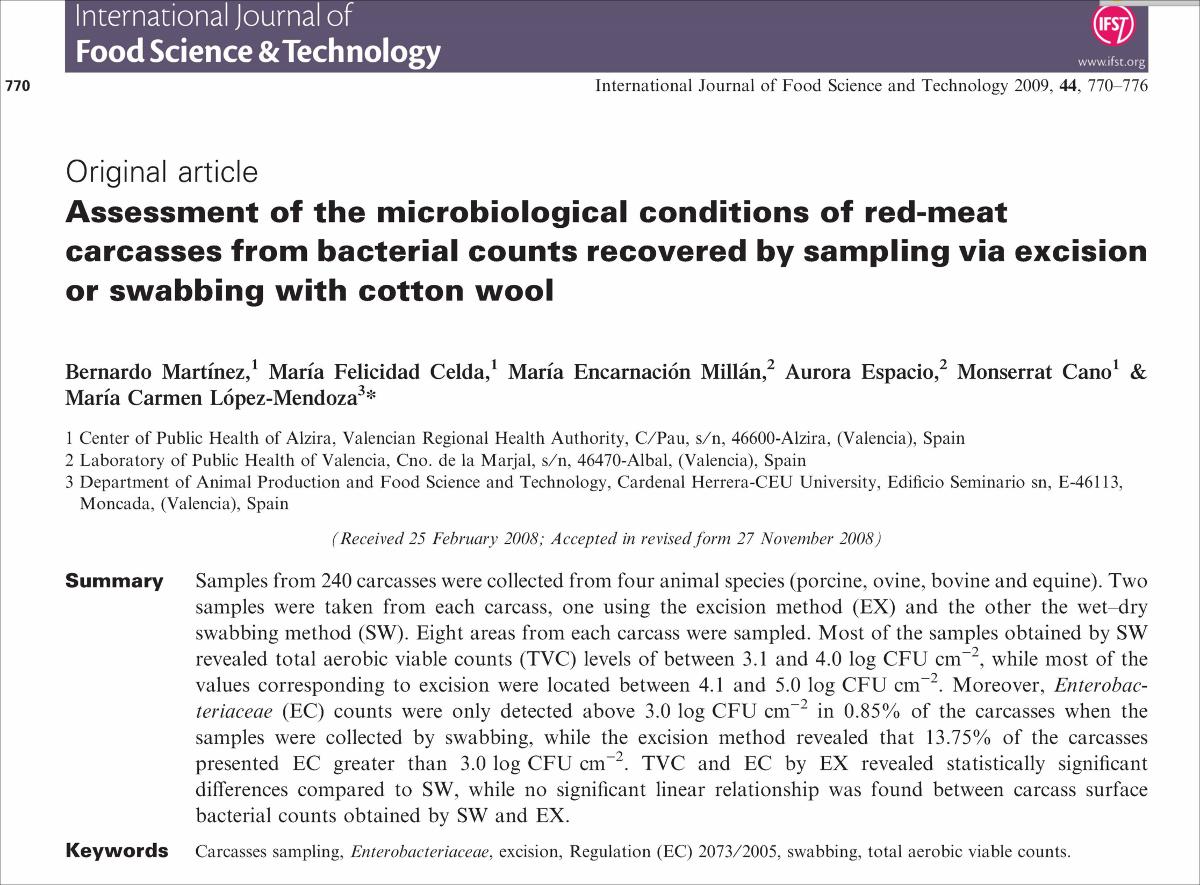Please use this identifier to cite or link to this item:
http://hdl.handle.net/10637/16292Assessment of the microbiological conditions of red-meatcarcasses from bacterial counts recovered by sampling via excisionor swabbing with cotton wool

See/Open:
Assessment_Martinez_IJFST_2009.jpg
1,92 MB
JPEG
See/Open:
Assessment_Martinez_IJFST_2009.pdf
Restricted Access
632,96 kB
Adobe PDF
Request a copy
| Title: | Assessment of the microbiological conditions of red-meatcarcasses from bacterial counts recovered by sampling via excisionor swabbing with cotton wool |
| Authors : | Martínez, Bernardo Celda, M. Felicidad Millán, María Encarnación Espacio, Aurora Cano, Monserrat López Mendoza, María Carmen |
| Keywords: | Industria cárnica; Meat processing industry; Seguridad de los alimentos; Food safety; Ganado; Livestock; Microbiología; Microbiology |
| Publisher: | John Wiley & Sons |
| Citation: | Martínez, B., Celda, M.F., Millán, M.E., Espacio, A., Cano, M., & López Mendoza, M.C. (2009). Assessment of the microbiological conditions of red-meatcarcasses from bacterial counts recovered by sampling via excisionor swabbing with cotton wool. International Journal of Food Science & Technology, 44(4), 770 - 776. https://doi.org/10.1111/j.1365-2621.2008.01895.x |
| Abstract: | Samples from 240 carcasses were collected from four animal species (porcine, ovine, bovine and equine). Two samples were taken from each carcass, one using the excision method (EX) and the other the wet–dry swabbing method (SW). Eight areas from each carcass were sampled. Most of the samples obtained by SW revealed total aerobic viable counts (TVC) levels of between 3.1 and 4.0 log CFU cm−2, while most of the values corresponding to excision were located between 4.1 and 5.0 log CFU cm−2. Moreover, Enterobacteriaceae (EC) counts were only detected above 3.0 log CFU cm−2 in 0.85% of the carcasses when the samples were collected by swabbing, while the excision method revealed that 13.75% of the carcasses presented EC greater than 3.0 log CFU cm−2. TVC and EC by EX revealed statistically significant differences compared to SW, while no significant linear relationship was found between carcass surface bacterial counts obtained by SW and EX. |
| Description: | Este recurso no está disponible en acceso abierto por política de la editorial. |
| URI: | http://hdl.handle.net/10637/16292 |
| Rights : | http://creativecommons.org/licenses/by-nc-nd/4.0/deed.es |
| ISSN: | 0950-5423 1365-2621 (Electrónico) |
| Issue Date: | Apr-2009 |
| Center : | Universidad Cardenal Herrera-CEU |
| Appears in Collections: | Dpto. Producción y Sanidad Animal, Salud Pública Veterinaria y Ciencia y Tecnología de los Alimentos |
Items in DSpace are protected by copyright, with all rights reserved, unless otherwise indicated.

